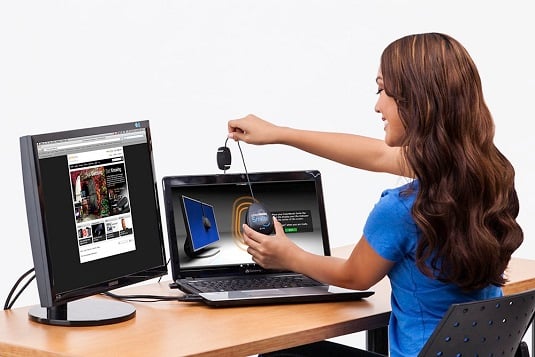How Do I Match Print Color To My Screen
To ensure that the monitor is displaying photos on a neutral sail, you can start with a software-based calibration utility, which is just a small programme that guides y'all through the process of adjusting the monitor. The program displays diverse color swatches and other graphics then asks y'all to provide feedback about what you see on the screen.
Both the Windows and Mac operating systems offer built-in calibration programs. If yous utilise a Mac, look in the Displays section of the Organization Preferences dialog; the utility is called Brandish Calibrator Assistant. Windows 7 and ten offer a similar tool named Display Colour Scale.
Software-based calibration isn't ideal, all the same, because people'south eyes aren't that reliable in judging color accuracy. For a more than accurate scale, yous may want to invest in a device known every bit a colorimeter, which you attach to or hang on your monitor, to accurately measure and calibrate the displayCompanies such as Datacolor and X-Rite sell this type of production forth with other tools for ensuring better colour matching. Here is the X-Rite ColorMunki Smile, for case, which has a suggested retail price of $109. As shown in the image, some products work with both laptop and desktop monitors, and some companies fifty-fifty offer tools designed for calibrating tablets. (Cheque the product specs to ensure compatibility with your screen and your computer or tablet'due south operating arrangement.)

Courtesy of 10-Rite, Incorporated For precise monitor calibration, invest in a colorimeter such every bit the ColorMunki Display from X-Rite.
Whichever route you become, the calibration process produces a monitor profile, which is a information file that tells your computer how to adjust the brandish to compensate for whatsoever monitor color casts. Your Windows or Mac operating system loads this file automatically whenever yous start your computer. Your just responsibility is to perform the calibration every month or so, because monitor colors migrate over time.
If your monitor is calibrated, colour-matching problems may be acquired by any of these other, secondary problems:- One of the print nozzles or heads is empty or clogged. Check the transmission to find out how to perform the necessary maintenance to keep the nozzles or print heads in skilful shape.
- You chose the wrong newspaper setting in your printer software. When you lot set up the print chore, be sure to select the right setting from the newspaper-type option — glossy, matte, and then on. This setting affects how the printer lays downwards ink on the newspaper.
Some newspaper manufacturers provide ICC profiles, which are minor data files that help your printer and computer better interpret your image colors to the specific newspaper you're using. (ICC stands for International Color Consortium, the group that developed the universal color translator on which this arrangement is based.) After you lot download and install the profiles, you lot should see the related paper types in the list of options in your printer settings dialog box.
If yous're using paper fabricated past the printer manufacturer, though, you don't unremarkably have to take this footstep; the profiles are automatically added when you install the printer software during initial setup.
- Your printer and photograph software are fighting over color-direction duties. Some photo programs offer features that enable the user to control how colors are handled as an prototype passes from camera to monitor to printer. Almost printer software too offers color-management features. The trouble is, if you enable color-management controls in both your photo software and your printer software, y'all can create conflicts that atomic number 82 to wacky colors.
Unless you're schooled in color management, let your printer handle things. However, it's wise to practise a few exam prints to see whether results are better when you hand the job to your photo software. Check your photograph software and printer manuals to find out the color-management options available to you and how to turn them on and off.
Even if all the aforementioned problems are resolved, yet, don't expect perfect color matching between printer and monitor. Printers simply can't reproduce the unabridged spectrum of colors that a monitor can display. In add-on, monitor colors always appear brighter because they are, later on all, generated with low-cal.
Finally, be sure to evaluate impress colors and monitor colors in the aforementioned ambient low-cal — daylight, function calorie-free, whatever — considering that light source has its own influence on the colors you see. If your prints will exist displayed in a gallery, you too should make certain that colors look good in any lighting the gallery uses. Ditto for prints you hang in your own home, of course.About This Commodity
This article can exist establish in the category:
- Editing ,
How Do I Match Print Color To My Screen,
Source: https://www.dummies.com/article/home-auto-hobbies/photography/editing/get-print-monitor-colors-sync-great-digital-photos-226026/
Posted by: wassermanquiuse84.blogspot.com


0 Response to "How Do I Match Print Color To My Screen"
Post a Comment